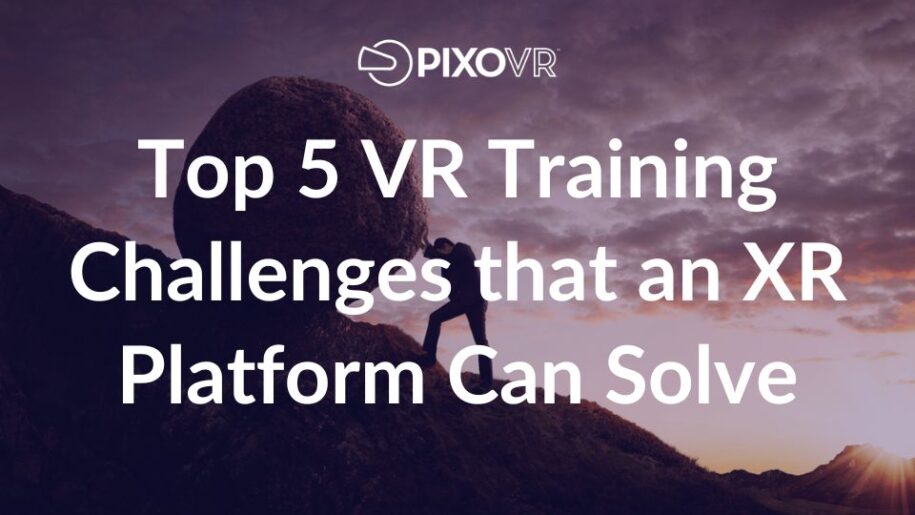Many enterprises attempted to use technology like virtual reality or augmented reality to attempt to improve training, but never reached widespread adoption because of the challenges they faced. Feedback from training managers who experimented with XR reported frustrations with technology, lack of support, and lack of the tools needed to be successful at scale. That said, when they got it working, the feedback was unanimous that XR training could improve outcomes.
This article will surface the top five challenges that training managers experienced when trying out XR training. We will also cover the capabilities in XR platforms that are now available to address these challenges. For those companies that haven’t yet tried it or are ready to try it again because of the clear benefits, this article is for you!
5 challenges with VR training
Most of the companies that have piloted VR training started with standard safety training or with a custom training for a hard skill that was difficult or costly to create scenarios for during training. These initiatives often came from Innovation Officers and training managers were not given the knowledge on how to implement this technology, let alone incorporate it into their existing training program. There are definitely organizational challenges around the best way to make a change on how things are done that made things more difficult. But, the top issues were all technology related.
- Handling different headsets and content types
In a small, controlled use of VR, like in a pilot, It is pretty easy to buy one headset type and ensure the content works with that headset. However, when a company tries to expand with more XR training courses and headsets in different locations, it gets very difficult to control compatibility. This is also true over time as new headsets are purchased that are a different version or different brand altogether.
An XR platform can solve this as they are built to handle content of all XR formats and ensure it works on any XR headset.
- Distributing content
One of the main value points of VR training is the ability to train employees in remote locations. That said, how do you get the right content on the right headset? Many training managers attempted to do this via side-loading (uploading the content to a headset directly via a USB drive). This requires shipping headsets back and forth, increasing time, cost, and the possibility of damage. As companies tried to scale their programs, this became a logistical nightmare.
An XR platform solves this with the capability of distributing content wirelessly to any headset in the world. It also removes the concern of getting the right content on the right headset as the platform distributes content by user. That means that when a user logs in to a headset, they can access any content that they have permission to use.
- Tracking use and performance
In a pilot setting, training managers monitored the training course use and any performance scoring manually. This was accomplished by having someone physically present to monitor who was taking the course and ask them to report out their score at the end. This process worked for the pilot, but was completely untenable for trying to do VR training at scale.
An XR platform automatically tracks all of the data on usage by user, group, and training content. This allows training managers to easily see what employees have completed training, how long it took them to complete, and how they scored. This enables a training manager to effectively manage the program, sending reminders as needed.
- Measuring success
Beyond tracking use, training managers felt they really needed some concrete data on how successful VR training was. In pilots, this typically involved surveying participants, but didn’t really get into ROI. Without this evidence, this made it difficult for companies to get approval to scale the use of VR training.
An XR platform collects all the data from the VR training and displays useful information on dashboards and reports for a clear picture of training success. Training managers can see whether or not the training time was reduced, whether employees achieved higher scores, and many other metrics that help a manager optimize the program.
- Scaling your program
Any of the four factors above may have been responsible for lackluster success with VR training, but the challenge of trying to scale a VR training program is the most daunting challenge without an XR platform.
An XR platform automates the management and execution of VR training at the scale of an enterprise. This allows training managers to worry less about technology difficulties and more about ways to get additional benefit out of VR training courses.
Scaling XR use pays off
A comprehensive XR platform allows large companies to get the full benefits of bringing XR into business operations. In VR training alone, when companies do this at scale they are realizing significant savings in training costs as well as improvements in employee productivity.
Where enterprises are seeing the ROI of early XR use:
- Reducing the costs of training
- Improving employee safety (which also reduces costs)
- Overcoming the skilled labor gap
- Keeping employees engaged and retained
- Improving employee culture and job satisfaction
You can now get a free ROI analysis for XR training. Learn more here.
Need help getting VR right? PIXO VR can help. Click here to arrange a meeting with a VR expert.
Want to read about companies that are realizing these benefits? This whitepaper on 5 Ways VR Training Can Help Companies Thrive gives lots of stats and real-life use cases.

Leave a Reply
You must be logged in to post a comment.